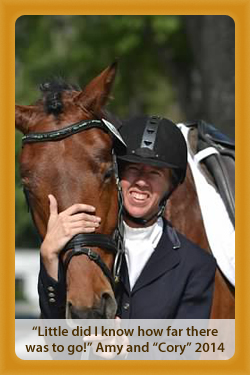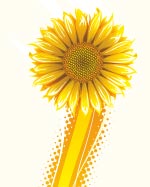

Amy Miller started her riding career as a horse-crazy girl riding bareback through southern California creeks and fields on a tolerant gray Arabian. As her interests and skills grew, Amy rode at a hunter/jumper barn and then was introduced to dressage when a new instructor joined that barn. Drawn by the incredible connection between horse and rider, Amy was hooked on dressage.
 Since then, Amy has earned her USDF bronze and
Since then, Amy has earned her USDF bronze and
silver medals and shown through Grand Prix and at national competitions. Recent accomplishments
include a 4th Place finish in the FEI 5 year olds at the 2014 Markel/USEF National Young Horse Dressage National Championships in Illinois, Reserve Champion of the FEI 4 year olds at the 2013 Markel/USEF National Young Horse Dressage National Championships in Illinois, Champion of the Five Year Old Open Futurity at the 2014 CDS Annual Championships, a 5th place finish in the FEI 6 year olds at the 2009 Markel/USEF National Young Horse Championships in Illinois and numerous high point awards with her own and students' horses at area competitions. Many students have earned their USDF bronze & silver Medals.
Amy also has her master’s degree in Physical Therapy, with specializations in orthopedics and strength and conditioning techniques. Amy’s medical training makes her uniquely qualified to evaluate the rider’s position from a biomechanical perspective. Equestrians with a history of orthopedic injuries including knee strains, low back pain or neck pain benefit from Amy’s ability to determine which riding exercises are safe for each individual rider.
“My favorite part of dressage is the process. Watching horses develop into graceful athletes, and riders develop into sensitive, balanced partners – this is the beauty and the best part of the sport.”
Amy Miller offers training and lessons at Rancho de Felicidad in Chino Hills.
An Interview with Amy Miller by Karen Davis
What were your early memories of horses?
We had horses at home in the backyard because my Mom rode. Our neighbors gave us a Shetland pony named Babydoll: she used to scrape me off on tree trunks, under low sections of the barn roof and if all else failed, she lowered her head and shook hard which made the saddle ride up onto her neck, me included. Next, Mom bought a nice big grey Arab gelding: he was meant for her, but he adopted me instead. I used to ride bareback all the time because I couldn’t lift the saddle that high. I’d climb up the pipe corral fence and crawl onto his back, then we’d set out for the trails, complete with picnic lunch.
What made you end up riding dressage as opposed to other horse sports?
Because I am the most exacting person in the universe so it fits me! Actually, I was taking jumping lessons when my instructor stopped teaching the jumping classes and started dressage lessons instead. I thought I was hot stuff because I was learning “lateral” movements. Little did I know how far there was to go!
Most important teachers, both horse and human?
Human, so far? Sherry Guess. Aside from the life lessons, she started working with Mary Wanless shortly after I started taking lessons from her. This brought about a whole new way to think about riding, from a perspective that included the biomechanics of the rider, including how to make the rider’s aids the most effective and the least destructive/blocking.
Horse: Again, so far: Dustin Joe, a Thoroughbred that used to run away with his other owner. One day, I just let him run until he was finished. Then we cantered for a while longer and he didn’t run away anymore. He taught me perseverance, patience and that the more I could sensitize my riding, the better results we could achieve.
How does being a Physical Therapist affect your riding?
The PT experience has helped me increase my problem-solving mindset. If it isn’t going well, then the PT part of my brain helps me take the task apart into smaller components to try and determine which part is missing or needs shoring up.
I plan my exercises for the horses based on muscles and mechanics. What we’re going to do each day, how we alternate different types of work, how many repetitions to try…but once I’m in the saddle, then it’s all about combining thinking, planning and feeling. When they merge perfectly, it’s magical.
As a Physical Therapist, have you gained insight into how a horse can move and how you can help train them in greater comfort?
I definitely think of the biomechanics of the horses. When a front leg doesn’t cross midline well enough during halfpass, when I’m grooming the next day I’ll poke around the scapula to see if I can find any muscular restrictions. When we’re struggling with collections, I check out the lumbosacral joint to see if there are muscle spasms or fatigue. I also try to be sensitive to the number of repetitions I request of new, difficult exercises.
Any horse in history to ride: who would it be and why?
Man o’ War – to feel the power of that stride.
Any instructor in history: who would it be and why?
Podhajsky from the Spanish riding school, because the horses were so systematically taught that the rider could take the skills to the next horse. It wasn’t a trick or by chance that the horses could perform all of the school movements.
What would you hope for your epitaph?
Passionate woman who gave her all without losing herself.
What would be the biggest compliment a student, and then an instructor, could give you?
Student: “I did it myself!” Such glee in their faces when they can reconstruct the work on their own!
Instructor: “I didn’t think that horse would be able to complete that skill, and now you have!”
Biggest positive moment as a horsewoman?
Discovering the music when you ride. One time at a horse show we were so in-tune with each other, each stride, each movement with such perfect timing, I rode to the music I heard, particularly at the canter. Then when I finished I asked if I could have a copy of the CD. Turns out, there wasn’t any music playing; all the music came from the inside, and that’s the biggest secret.


